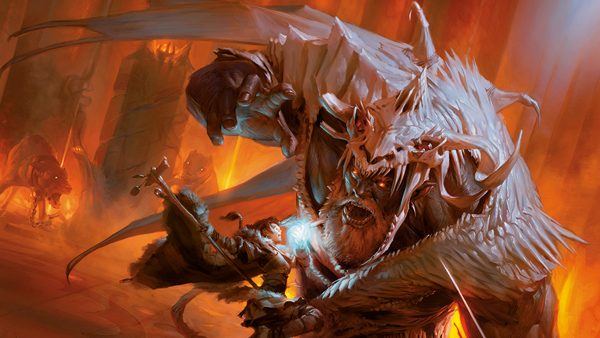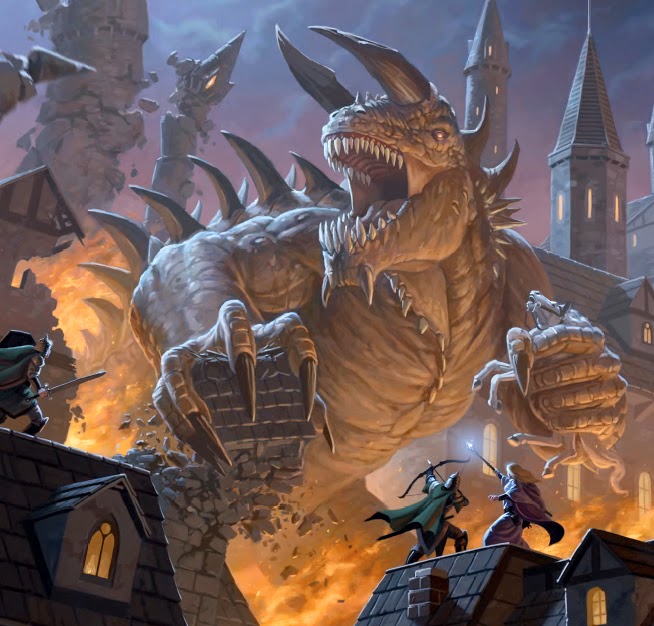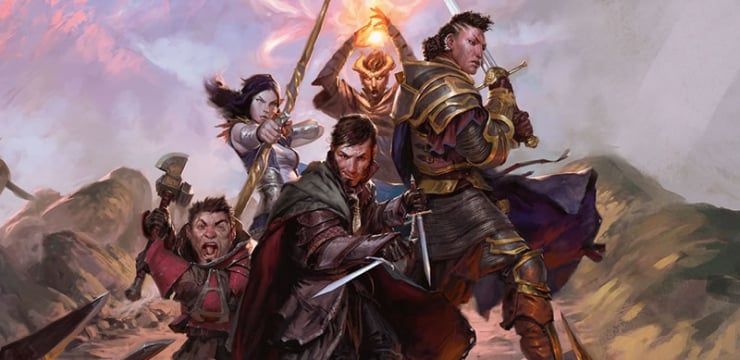D&D 5th Ed: Why You Should Try It



Let’s delve into the latest edition of Dungeons and Dragons and compare it to past editions and Pathfinder. You’ll see why it is a wonderful edition to try.
Hello again. Edwin here and today I want to talk to you about the newest edition of D&D. We will go in depth about what makes this possibly one of the best editions of the game. A lot of things were revamped from previous editions. The major changes really mashed a lot of the best of previous editions together into something greater than the sum of all its parts. Those who played 3.5 or Pathfinder will feel at home in this new edition save a few minor changes. There are a lot of changes in the new edition, so we will only discuss he majors ones. The major things we are going to discuss is the change in the skill system and how it effects game play, the changes in combat and the way monsters are designed, how spell casting and rituals changed, Archtypes and class changes, and the overall pro’s and con’s between 5th edition D&D and 3.5 D&D/Pathfinder.
Perform:Seduction is still not a skill
Skills & Backgrounds
The skill system was completely overhauled. The big change from 3.5 and pathfinder is that they eliminated actually giving you points to put in skills. Instead, you get to pick skills that you can do well. This means that save for a handful of skills, you primarily use your ability modifier. This systems seems like it would reduce the choices you have in skills, but they also reduced the list of skills also. On top of that, the skills you are proficient in get a good bonus, but one that won’t let you instantly win a skill check versus someone who doesn’t have the skill. You get between +2 to +6 depending on your level from one to twenty. The number of skills and which skills you get depends on two factor. You class has a certain number of skills you get that you can pick from. These skills all pertain to what the class would get. Wizards can get skills like arcane, fighters can get things like athletics, and rogues get sneak. Things like that. If you want skills outside of what your class can do, you have the second option for skills, your background. Your background is what you did before your life up to the point where you became an adventurer. It helps to fill out your character and show you did something other than just kill monsters and take their things your entire life. These vary greatly, so you can get a wide variety of skills and they all come with a separate power that flesh out how your backstory. They even show how you can make your own background to better fit the role and life you wanted previous to adventuring. On top of background , there are also other small ways. Some select race get a couple extra skills and there is even a feat that can give you more skills. With the list of skills down from the massive amount is was to 18, you can learn a good amount of skills, but not everything. They really make it to where skills are noticeable, but they are not the craziness that was the D&D 3.5 skills.
Lions, Tigers, and … god help us.
Monsters!
One of the big changes in the game was how monsters are made and how combat works. The monster’s design changed in a really good way. Rarely is a monster going to lay the smack down on you like they could in earlier editions. They do a lot less damage and only have a couple of attacks most of the time. Their attacks feel more meaningful. In 3.5, a dragons could have claw,claw, tail, wing, wing, and bite for attacks. If it missed with one of those, o well, it has easily 5+ more. Now, if a claw misses, you dodged a bullet. When someone attacks, the “attack” action now lets you do your full attack so you can do more with your turn besides punch someone in the face.They kept the 4th edition idea of designing monsters to fill a role and this helps in making dynamic and diverse encounters very easy. When it comes to hitting monsters, the changes they made to AC often means it doesn’t get very high. It is easier for everyone to hit. It is quick, clean, and easy. They made up for this by giving everyone a lot more HP. You aren’t going to get lucky and one shot a monster most of the time. At the same time, you aren’t at as much of a risk of getting one shot either, even as one of the more squishier classes. They also added in two things for boss monsters. They can have lairs that have effects when you fight someone inside their lair. They often even increase the CR for fights inside the lair. They also added legendary actions. These are actions that can take place outside of the monster’s turn and make for a more dynamic fight. All of this combined into a combat system that is quicker because you will often have to look less in the book, but longer because the fights have less risk of someone walking up and rolling a natural 20 and backhanding an encounter before it even gets started because the dice love them and vice versa for the monsters.
As much as we try, we will never be Nicholas Cage casting fireball cool.
Magic
Spells got a pretty big overhaul this edition. You can now cast certain spells as a ritual. They take longer to cast, but they don’t consume a spell slot when cast this way. Spells in general got more powerful for three reason. First and foremost, spell casting doesn’t provoke attacks of opportunities unless they have special rules for it. They limited attack of opportunities to only really be when someone moves out of threat range so you don’t get punched in the face as often for casting spells. The save for spells is more universal now. Your strongest spell and weakest spell will have the same save. Because you cast the weaker spells more often, this tends to make them stronger. It is less about the spell and more about the caster now. This also means you have to look up less. All saving throws someone has to take is one universal number. Spells also got stronger in that most spells can be cast at a higher level than the one they provide in the book. This often causes the spell to hit more people or do more damage. This means, you can diversify your spell list and still have damage. A fireball cast with a higher spell level does more damage. This means if you want to take utility spells instead of higher damage spells, you can. It opens the option for more flexibility in spell lists. They make up for these two buffs in one distinct way. Everyone knows a lot less spells. The classes that have this as a class weakness such as sorcerer or warlock see this a lot. They know an incredibly small number of spells and this means they often take less damage spells. There is no way to know more spells through modifier and even some of the bonus spells only extend the spell lists unless the specifically say you know them too like the cleric domain’s. It really makes spell choice really hard at times. It is more than take the iconic spells like fireball, lightning bolt, and identify. Finally, they also changed spells to have the requirement of concentration. Some spells that were really powerful when cast over and over again require you to concentrate to keep their effect going. You can’t just use hold person over and over again on a lot of targets. You have to concentrate on them and they can be broken when attacked. A lot of buffs require you to concentrate. They made buffs more powerful at least.
Fireball your party, they will never see it coming.
Classes
The classes all got overhauled in great ways in this new editions. All of the melee classes few like they were brought to rank up with the spell casters and the spell casters were changed in just enough of a way to tone down their power. The attack action gets you all of your attacks and lets you move still. Most of the melee feats were gotten rid of and most people can just do those actions without feats. The classes are wonderfully diverse from each other.Everyone has their own unique mechanic and even the fighter has a lot of things besides punch someone in the face. Even among the classes themselves, every class has a growing list of archetypes. These archetypes changes the way a class works. We will use the fighter for example. The fighter’s three archetypes in the Player’s Handbook are eldritch knight, champion, and battle masters. The eldritch knight is a spell slinging swordsmen with a plethora of tricks, the champion is a traditional fighter with sword and shield wadding into battle, and the battlemaster controls the enemy through hindering and moving the enemy around in favorable ways. Each takes someone who in past editions just punches people in the face and changes the way they function while still being the same class. The only big downside to the archetype system we have now is that prestige classes haven’t really taken hold yet. They previous prestige classes are all archetypes now so if you want to be an assassin you must go rogue and eldritch knights are fighters. Also, some of the classes have weird power curves with some classes getting incredibly devastating cap stones , which is what the end ability in a path is called, or often can be utterly worthless in the grand scheme of things. This is nothing a good tweaking couldn’t fix.
Pros & Cons
So this may have all been a little TLDR, but you could go into entire articles about each and every points. I think a nice little break down of the pros and cons of 5E. This won’t a complete list of pros and cons, but it really will hit the big ones. Also, there is a wonderful surprise at the end for those who have stayed this long.
I love you google
- 5E D&D skill set is quick, clean, and easy to understand. It may be a little simplistic at times, but the system makes your actions the center point instead of the what you roll. How well you roll is still a factor, but it isn’t the be all and end all it was in older editions.
- Combat has evolved into a more dynamic encounter that doesn’t consume every feat you have in order to do more than walk up and punch someones face off. Monsters are the same and it makes combat flow better. It may take longer, but it reduces the chance that combat is going to end because someone rolled really well. It makes fights easier to handle.
- Spells feel more meaningful on every level. They often can do more and can be powered up. The damage spells are easier to use as they scale with spell level, the utility spells work better and have become more powerful, and even cantrips have their own distinct use. Also, spell saving throw is one universal save now.
- The variety of classes offered really does make an already unique feeling class feel specialized. Even the melee classes have distinct feels and charm all their own. Even bards are quite a bit more useful than before.
- The game is really set to rewards crafting and creating what fits for you and your story. The bound system that is in place means creating something all your own has never been easier. Balance is there in spades and overall this is probably the best edition of the game I have played yet.
I hate you google
- The skill system at time is really simple. Sometimes to simple. You may not have to look at your character sheet almost ever for it, but you are either good or you aren’t with a skill. The books only have so many backgrounds. We need just a few more.
- Fights can sometimes take a little longer than they should. When a CR 2 creatures has nearly 100 hp, it can take a while to cleave that path through the dungeon.
- No one really knows that many spells. This really puts an emphasis on what spells you pick and their importance. If you don’t play these classes often, this because a really hard decisions and can kneecap a character if they aren’t careful. Playing a caster has never been harder, but it has never been as fulfilling either.
- Sometimes, the Archetypes can get a little silly. The beast master for ranger at times feels so incredibly useless and needs a complete work over and some of the capstones for things like battle master fighter make you cry on the inside when compared with death strike (comparing a single extra maneuver if you don’t have any left at the start of combat compared to a constitution save or take double damage from a certain attack. They don’t compare all that well.) Like backgrounds, we just need a few more books with Archetypes to really get them going.
- While the game is easy to mod and add on to, sometimes, you may need to do that to make it make sense. You can see the feel that they were going for, but somethings don’t really work.
And now time for the big reveal at the end. Wizards of the Coast did something no one saw coming as I was writing this. The gave us this D&D System Reference Document.This document is the basis for 5th Edition D&D. You can go look for yourself and see what this game has to offer now before you ever make an investment. Pathfinder did this with great success and now WotC have done it.
So here is a brief overview of 5E D&D. It isn’t everything, but it is enough to get started. With the provided SRD, you can see for yourself on what this edition is all about.










